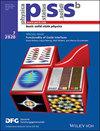刚玉结构掺锡氧化铟薄膜对伽马射线辐照的耐受性
IF 1.8
4区 物理与天体物理
Q3 PHYSICS, CONDENSED MATTER
引用次数: 0
摘要
研究人员将刚玉结构掺杂锡的氧化铟(rh-ITO)作为一种新型透明导电氧化物。在此,研究人员考察了其对伽马射线的耐受性(总剂量达 77 kGy),以了解其在太空等恶劣环境中的潜在应用。研究针对 Sn 浓度分别为 0% 和 5% 的 rh-ITO 进行。X 射线衍射 2θ-ω 扫描分析表明,伽马射线辐照不会导致相分离。辐照后,未掺杂的 rh-In2O3 中的载流子浓度增加,这表明伽马射线置换了氧原子并形成了氧缺陷,从而产生了供体。辐照后,rh-In2O3 和 rh-ITO 仍保持较高的可见光透明度。这项研究证明了 rh-ITO 在 77 kGy 剂量之前对伽马射线辐照的高稳定性。这项工作有助于将 rh-ITO 用作高辐射环境中的电极。本文章由计算机程序翻译,如有差异,请以英文原文为准。
Tolerance of Corundum‐Structured Tin‐Doped Indium Oxide Thin Films to Gamma‐ray Irradiation
Corundum‐structured Sn‐doped indium oxide (rh‐ITO) is investigated as a novel transparent conductive oxide. Herein, its gamma‐ray tolerance up to a total dose of 77 kGy is examined for potential applications in harsh environments, such as space. The investigations are conducted on rh‐ITO with Sn concentrations of 0 and 5 at%. X‐ray diffraction 2θ‐ω scan analysis reveals that no phase separation occurs due to gamma‐ray irradiation. The carrier concentration in undoped rh‐In2 O3 increases after irradiation, indicating that the gamma rays displace the oxygen atoms and form oxygen defects that generate donors. The high visible light transparency of rh‐In2 O3 and rh‐ITO is maintained after irradiation. This study demonstrates the high stability of rh‐ITO to gamma‐ray irradiation until 77 kGy dose. This work contributes to the application of rh‐ITO as an electrode in high‐radiation environments.
求助全文
通过发布文献求助,成功后即可免费获取论文全文。
去求助
来源期刊
CiteScore
3.30
自引率
6.20%
发文量
321
审稿时长
2 months
期刊介绍:
physica status solidi is devoted to the thorough peer review and the rapid publication of new and important results in all fields of solid state and materials physics, from basic science to applications and devices. Being among the largest and most important international publications, the pss journals publish review articles, letters and original work as well as special issues and conference contributions.
physica status solidi b – basic solid state physics is devoted to topics such as theoretical and experimental investigations of the atomistic and electronic structure of solids in general, phase transitions, electronic and optical properties of low-dimensional, nano-scale, strongly correlated, or disordered systems, superconductivity, magnetism, ferroelectricity etc.

 求助内容:
求助内容: 应助结果提醒方式:
应助结果提醒方式:


